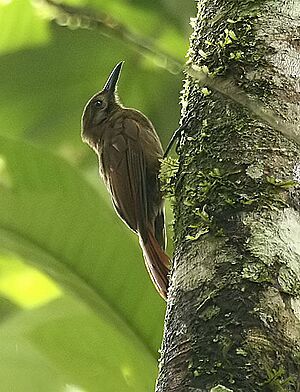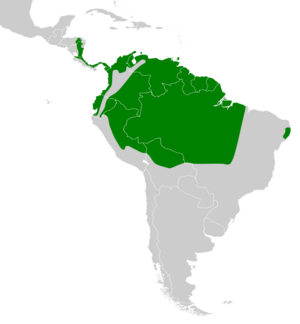Plain-brown woodcreeper facts for kids
Quick facts for kids Plain-brown woodcreeper |
|
|---|---|
 |
|
| Conservation status | |
| Scientific classification | |
| Genus: |
Dendrocincla
|
| Species: |
fuliginosa
|
 |
|
| Range of D. fuliginosa including D. turdina taunayi (see Taxonomy section) | |
The plain-brown woodcreeper (Dendrocincla fuliginosa) is a cool bird found in the tropical parts of the New World. This includes places from Honduras all the way down through South America to central Brazil, and also on the islands of Trinidad and Tobago. It's a type of sub-oscine passerine bird, which means it's a perching bird. It belongs to the ovenbird family called Furnariidae.
Contents
Understanding the Woodcreeper's Family Tree
The way scientists group the plain-brown woodcreeper is a bit tricky. Different groups, like the International Ornithological Committee (IOC) and the Clements taxonomy, have slightly different ideas.
For example, they agree on 11 main types, or subspecies, of the plain-brown woodcreeper. But one subspecies, taunayi, is sometimes included with the plain-brown woodcreeper by some groups. Other groups, like the IOC and Clements, say it belongs to a different bird called the plain-winged woodcreeper.
In the past, some of these subspecies were even thought to be completely separate species. For this article, we will follow the idea that there are 11 subspecies of the plain-brown woodcreeper.
What Does the Woodcreeper Look Like?
The plain-brown woodcreeper is about 19 to 22.5 centimeters (7.5 to 8.9 inches) long. Males usually weigh between 30 and 50 grams (1.1 to 1.8 ounces). Females are a bit smaller, weighing 25 to 46 grams (0.88 to 1.6 ounces).
This bird is a medium-sized member of its group. It has a straight bill that is medium in length. It also has a slight crest on its head. Both male and female birds look the same, but females are smaller.
The most common type, called D. f. fuliginosa, has a thin, light stripe above its eye. It also has a faint light stripe under its grayish face. Its head, neck, back, and wing feathers are a dull olive-brown color. Its tail feathers are a reddish-brown. Its wings are also reddish-brown with darker edges.
Its throat is light gray to buffy with small spots. Its chest and belly are lighter olive-brown than its back. They have thin, light streaks. The feathers under its tail are cinnamon-red. Its eyes can be yellowish-brown to dark brown. Its bill is black with lighter edges and tip. Its legs and feet are dark, like black or slate gray.
Other types of the plain-brown woodcreeper have small differences. Some might be more reddish or more olive in color. Some have more or fewer spots and streaks. Their throats might be lighter or darker. Their bills can also vary slightly in color.
Where the Woodcreeper Lives
The plain-brown woodcreeper lives in many different kinds of wet forests. It is most often found in evergreen forests, where trees stay green all year. It also lives in deciduous forests, where trees lose their leaves, and gallery forests, which grow along rivers. You can also find it in rainforests and forests on sandy ground. Sometimes, it even lives in mangrove swamps.
In the Amazon Basin, it mostly lives in terra firme forests, which are on higher ground. It also lives in floodplain forests. It is less common in várzea (flooded) and swamp forests.
This bird prefers the inside of primary forests, which are old, untouched forests. But it is also often seen at the edges of these forests and in older secondary forests, which have grown back after being cut down. It is not common in young secondary forests or in bamboo patches.
The plain-brown woodcreeper is a bird of lowlands and foothills. It usually lives below 1,300 meters (4,300 feet) in most areas. In some places, like near the Caribbean coast in Colombia and Venezuela, it can be found as high as 2,000 meters (6,600 feet).
Woodcreeper Behavior
Movement and Travel
The plain-brown woodcreeper stays in its home area all year long. It does not migrate long distances. However, scientists think it might make some small, local movements within its territory.
How the Woodcreeper Finds Food
The plain-brown woodcreeper usually looks for food in the lower and middle parts of the forest. It eats many kinds of arthropods, like beetles and grasshoppers. It also eats small animals like lizards.
This bird often follows army ant swarms. As the ants march, they scare other insects and small animals out of their hiding spots. The woodcreeper then catches these fleeing creatures. However, it doesn't only follow ants. It also hunts alone or with groups of different bird species. Sometimes, it even follows South American coatis (a type of raccoon) or monkeys to find food.
When it's with an ant swarm, the woodcreeper clings to a tree trunk or vine. It usually stays about 4 to 10 meters (13 to 33 feet) above the ground. It makes short flights to grab prey from other trees, leaves, the ground, or even in the air. When it's not following ants, it might perch higher or lower, and on horizontal branches.
Reproduction and Life Cycle
The plain-brown woodcreeper's nesting time changes depending on where it lives. In Central America, it nests from May to October. In the Amazon region, it seems to nest from August to December.
The bird builds a cup-shaped nest. It uses dead leaves, plant fibers, and soft plant down. The nest is placed at the bottom of a hole in a tree stump, bamboo, or a palm tree. Sometimes, it might first fill a deep hole with moss before building the nest.
It seems that male and female woodcreepers only stay together for a short time. Only the female bird is known to sit on the eggs and take care of the young. A female usually lays one to three eggs. We don't know how long the eggs take to hatch. But the young birds leave the nest about 23 to 25 days after they hatch.
Woodcreeper Sounds
The plain-brown woodcreeper's song is described in different ways. Some say it sounds like a long whinny, a rattle, or a sputter. People have tried to write down its song as "Whee-hee-he-hah-huh-huh-huh-huh-huh-huh-huh-hu-hu-hu-hu-hu-hu-hoo-hoo-hooh, wee-i-woo!" or "keé-keé-keé-kee-kee-kee-kew-kew-kew". It also makes a "long series of sweeping 'weekweekweek---' notes".
It makes many different calls too. The most common ones are "peeyk" (or "PWEEK!"), "stieek", and "squeeeik". Other calls include "sweeuh", "chauhh", "cheeng, cheeng", and "pooo".
Woodcreeper Status and Conservation
The IUCN (International Union for Conservation of Nature) has looked at the plain-brown woodcreeper. They say it is a species of Least Concern. This means it is not currently in danger of disappearing.
This bird lives across a very large area. Scientists estimate there are at least five million adult birds. However, the total number of birds is thought to be going down. This is because its home, the forest, is being cut down. The plain-brown woodcreeper is sensitive to forests being broken up and to human activity.
Even with these challenges, it is the most common and widespread type of Dendrocincla woodcreeper. It is considered uncommon to common in most places it lives. It is thought to be less sensitive than other birds that rely only on army ants. Its numbers might stay steady even in forests that have been partly cut down or in small forest areas.


